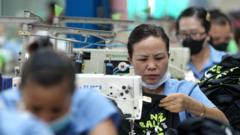With the introduction of sweeping tariffs by US President Donald Trump, Vietnam and Cambodia find themselves under significant economic pressure, with tariffs reaching 46% and 49% respectively. In comparison, Thailand faces a 36% tariff, and lower rates are applied across Indonesia, Malaysia, the Philippines, and Singapore. These punitive measures threaten the export-dependent economies of Southeast Asia, where Vietnam’s exports to the US constitute a staggering 23% of its GDP, and an alarming 67% for Cambodia.
The trade landscape has been evolving after three decades of remarkable growth, primarily fueled by strong export performance. This success is now at risk as tariffs jeopardize future exports, which are integral for these countries particularly as they strive to meet ambitious economic targets.
Vietnam's plan to transition into a knowledge and tech-driven economy hinges largely on maintaining strong trade links with the US. The Communist Party, led by To Lam, relies on the economic growth to solidify its political legitimacy. However, current economic forecasts suggest achieving desired growth rates of over 8% annually would now be an uphill battle.
Although Thailand has less exposure to US exports, its economy has been underperforming, complicating its ability to weather additional economic shocks. The Thai government is exploring options to bolster growth, but rising tariffs further impede their efforts.
In Cambodia, the political landscape is becoming increasingly precarious due to economic instability induced by tariffs. The administration, which has been authoritarian under Hun Manet, is vulnerable as rising unemployment and dissatisfaction among the populace could fuel dissent.
Southeast Asian governments are adopting a stance of diplomacy rather than aggression, seeking negotiations instead of retaliatory measures. Vietnam's deputy prime minister is reportedly in Washington working towards alleviating tariff burdens, while similar efforts are underway from Thai and Malaysian officials.
Despite these overtures, the Trump administration appears firm, with senior trade adviser Peter Navarro criticizing Vietnam’s tariff proposals and suggesting other non-tariff barriers exist. This tension raises the stakes further for the region's economies, already grappling with external pressures.
Asian markets responded negatively to the tariffs' introduction, exacerbating fears of an economic downturn. Countries like Myanmar emerge as outliers, facing high tariffs despite their minimal reliance on US trade.
Historically, Trump has enjoyed popularity in Vietnam, respected for his bold foreign policy. Yet, as economic ties fray under the weight of tariffs, nations across Southeast Asia now find themselves navigating a precarious diplomatic landscape.
The future remains uncertain as these economies attempt to balance longstanding alliances with the challenges presented by US trade policies. Each interaction becomes critical as these nations fight to maintain their economic standing amidst a tumultuous international trade climate.




















